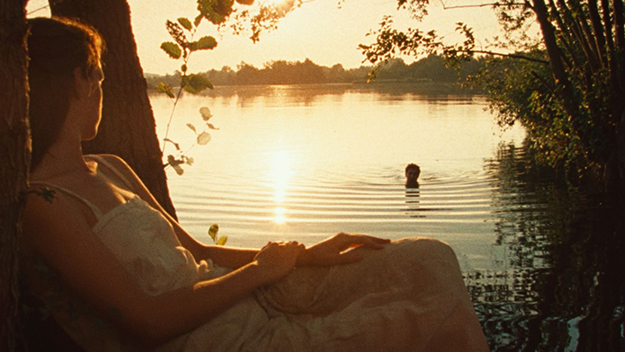Review: Scarlet
This article appeared in the June 8, 2023 edition of The Film Comment Letter, our free weekly newsletter featuring original film criticism and writing. Sign up for the Letter here.

Scarlet (Pietro Marcello, 2023)
Set in the French countryside between world wars, Pietro Marcello’s Scarlet is a tender, sumptuous fairy tale, adapted with painterly sensitivity from a 1923 novel by Soviet author Alexander Grin. Raphaël Thiéry gives a late-age breakout performance as Raphaël, a heavy, dour man who returns from World War I to find his wife deceased and his infant daughter Juliette in the loving arms of a caretaker named Madame Adeline (Noémie Lvovsky). When he learns about an act of violence that implies Juliette may not be his own, Adeline sets him straight, reinforcing his fatherly duty and sticking by him with platonic devotion as Juliette’s adoptive mother. Raphaël’s big, leathery workman’s hands possess a refined skill, but his ability to earn a living from them by carving ships’ masts is undermined when the townsfolk turn on him after a passive act of malice against his late wife’s aggressor. Working independently, he discovers a talent for crafting children’s toys, delicate wooden baubles that he sells to a toy-store owner in a nearby town. As Juliette grows up, she and Raphaël develop an unbreakable, intimate bond, insulated against the hateful villagers and undisturbed in its simplicity—until a handsome pilot played by Louis Garrel falls from the sky.
Marcello’s eye for cinematic faces pays dividends with the assemblage of his cast. Thiéry’s remarkable mug appears cut from wood, a natural companion to a statuette Raphaël carves of his wife, while young discovery Juliette Jouan—who plays the adult Juliette—manipulates her angular features with such dynamism, turning a smile to a glower or the reverse in an instant, that it’s hardly jarring when Juliette breaks into song halfway through the film. (Marcello, a noted fan of Jacques Demy, has said of this apparently unplanned transition, “My actresses wanted to sing, so I said why not?”) Even the village extras and supporting players, who include French stalwarts François Négret and Yolande Moreau, seem meticulously chosen to exclude anyone who might look too modern or indistinct. How else could it be that Garrel, with his goofy mustache, has the most boring face in the film?
That the two protagonists of this fictitious and at times fantastical odyssey bear their actors’ names nods to Marcello’s documentary impulse. The director began his career in nonfiction and has returned to it several times, as with his last two films: 2021’s Futura, directed in collaboration with Francesco Munzi and Alice Rohrwacher; and For Lucio (2021), a tribute to Italian singer-songwriter Lucio Dalla. As in Martin Eden (2019), Marcello’s last narrative film, Scarlet makes use of colorized archival footage to fill in period details and gaps in time, though its rhythmic, artful incorporation exceeds any merely practical function. At times, the contemporary footage is manipulated to match seamlessly with the archival, as in multiple instances of artificial fading or reddening. One brief establishing clip of a promenade is drawn from Julien Duvivier’s 1930 drama Ladies’ Paradise, though one wouldn’t guess it was from a fiction film if one didn’t know the source. Roving 16mm cinematography adds to the verité feel of the film, which, except for the ample cutting, sometimes resembles the short Albert Maysles shot for Jean-Luc Godard, Montparnasse et Levallois (part of the 1965 omnibus Six in Paris): meticulous mise en scène contrasts with handheld camerawork that seems to follow the action more than anticipate it.
In a way, though firmly a narrative film, Scarlet extends the aesthetic approach of Marcello’s docufiction feature The Mouth of the Wolf (2009), which features a similarly deft blending of archival and original footage. Marcello, who studied in Moscow and made a film dedicated to mentor Artavazd Peleshian (The Silence of Peleshian, 2011), here demonstrates a dialectically precise command of montage alongside editors Carole Le Page and Andrea Maguolo. The footage of Armistice Day that opens Scarlet both sets a pacifist tone and implies unseen violence, while later images of a burgeoning industrial world cast the delicacy of Raphaël’s handiwork in sharp relief. Vivid footage of steam trains, both archival and non, encroaches on the leafy calm of village life, recalling the famous train scene in Satyajit Ray’s 1955 Pather Panchali; as with Garrel’s fallen pilot, it’s not just masculinity but modernity that interrupts Raphaël and Juliette’s quiet life.
Marcello reestablishes his standing as one of contemporary cinema’s great magician-filmmakers, while remaining rooted in a spirit of the real. He’s a counterpoint to Andrew Sarris’s dichotomy between the Méliès and Lumière molds—cinema as illusion vs. realité—in his deep attunement to both cinematic traditions. If Scarlet feels less ambitious than the sweeping Martin Eden, whose social-climbing hero ends up disgusted by life, it is so by design, reflecting Juliette’s gentle nature and contentment with the simple pleasures around her (if also the exigencies of a lower-resourced production conceived and shot during the pandemic). Unhindered by any seeming contradictions between truth and illusion or documentary and fiction, Marcello has found his footing at the point where they meet, better equipping him to evince the wonder in the everyday.
Inney Prakash is a film curator and writer based in New York City.







